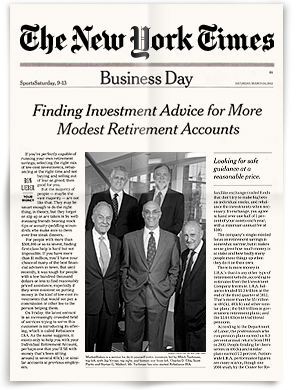Outdated Retirement Advice You Should Avoid

Managing Director Mitch Tuchman spoke with U.S. News about why the standard 60% stocks 40% bonds split is no longer relevant for retirement investors.
Some things are timeless. They never go out of style. But the same can’t be said for retirement advice. Retirement today looks vastly different than it did for seniors of generations past. Workers now have access to a variety of new retirement accounts, and the economy looks markedly different than it did when people were leaving the workforce in the 70s, 80s and even 90s.
If you want to retire comfortably, some experts say you need to modernize your thinking on the following four pieces of outdated retirement advice.
Outdated advice: A 60/40 portfolio split is safe and profitable.
More modern take: An 80/20 split may be better suited for most people.
Workers have long been advised that a 60/40 split in their portfolio is ideal. By placing 60 percent of their money in stocks and 40 percent in bonds, they would be able to assure adequate growth while keeping a significant amount of assets secure in low-risk investments. “In the past, you’d be able to get 3, 4 or 5 percent on a no-brainer bond portfolio so [a 60/40 split] was a very standard move for wealth advisors,” says Mitch Tuchman, Managing Director at Rebalance. “It was as predictable as shifting gears in a car.”
However, in today’s low-interest-rate environment, bonds are earning practically nothing. What’s more, people are living longer, which means even if bonds were performing better, they may not earn enough to sustain a person’s income throughout retirement.
Instead of going with the old 60/40 advice, Tuchman says many people may be better served with an 80/20 split that puts more money in stocks. He acknowledges some people have an aversion to the risk presented by stocks, but he adds they have always gone up in value over a 10-year period.
Outdated advice: You should use your age to allocate your portfolio.
More modern take: Low interest rates mean you need more money in stocks.
A similar bit of advice tells workers to use their age to determine how much money should go into stocks and bonds. Under this rule of thumb, a 30 year old would allocate 30 percent of his portfolio to bonds and 70 percent to stocks while a 70 year old would have 70 percent in bonds and 30 percent in stocks. “It’s a dreadful strategy because it ignores how long people live nowadays,” says Joe Duran, CEO of United Capital in Newport Beach, California. Like Tuchman, Duran says people should keep more money in stocks where they can earn enough gains to last for what could be a 30-year retirement.
For those in retirement who balk at the idea of leaving their savings in higher risk funds, Duran recommends pulling out two to three years of income and keeping it in a savings account for peace of mind. If the market tanks, you’ll have enough money in savings to live on while waiting for the price of stocks to recover.
Outdated advice: You can safely withdraw 4 percent of your retirement fund each year.
More modern take: How much you withdraw should be a year-to-year decision.
For years, 4 percent has been the magic number when it comes to taking withdrawals from retirement accounts. Retirees were advised this amount would make their savings last the rest of their lives.
The problem is retirement funds nowadays don’t reliably have gains each year. “Last year, it was almost impossible to get 4 percent on your portfolio,” Duran says. Those who took out that amount were likely dipping into their principal. Doing that consistently could cause a person to either run out of money in retirement or eat away at any inheritance they expected to leave.
A more modern approach is to skip the rule of thumb and decide annually how much to withdraw based upon current market conditions.
Outdated advice: Workers should be given lots of information and choices to plan for retirement.
More modern take: Automating the system and removing decisions works better.
With the advent of 401(k) plans and IRAs, workers had to pick up the reins and direct their own retirement plans. Gregory Kasten, founder and CEO of Unified Trust Company in Lexington, Kentucky, says people have been stymied from taking action by a collection of forces that include procrastination and choice overload. Rather than try to bulk up workers with resources, tools and planning calculators, Kasten says the more modern thing to do is actually a throwback strategy. “We have to make the modern 401(k) like the old-fashioned pension plans,” he says. That means automatically enrolling workers and automatically increasing their contributions. Beyond that, Kasten says it’s typically better to present workers with an investment plan to approve rather than encouraging them to research their investment choices and make their own decisions.
Removing choice may seem like a step backward, but Kasten says his experience has shown workers are happier when someone else is calling the shots. For the plans it administers, Unified Trust Company provides a personal report for each worker along with a recommended investment strategy. “About 95 percent of participants will just take what we set up for them and go with it,” Kasten says.
Following outdated retirement advice can leave retirees with too little money to pay expenses over many years of retirement. The four beliefs above aren’t timeless, but there is one piece of financial advice that is: Consulting with a professional may be the best way to create a personalized plan for a secure future.






